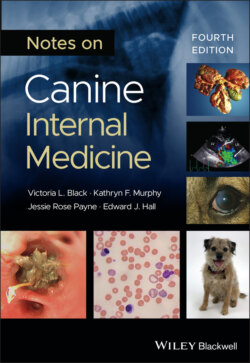Читать книгу Notes on Canine Internal Medicine - Kathryn F. Murphy - Страница 11
ОглавлениеUSING THIS BOOK
SECTION 1
Presenting complaints
In this section, the common presenting complaints are listed alphabetically according to a stylised format.
Each problem is defined, and the expected clinical signs listed although not every case will show every sign.
Causes for the problem are divided into ‘common’ and ‘uncommon’ to guide the reader, but are only the opinion of the authors, and may vary in different geographical locations.
For each problem a logical diagnostic approach is suggested; any numbering indicates a suggested order for the investigations:Clinical clues in the history.Potential findings in the clinical examination.Laboratory findings that aid the diagnosis.Key results from imaging.Special tests that may confirm the diagnosis.
SECTION 2
Physical problems
In this section, significant findings from the physical examination are listed alphabetically.
Each problem is defined.
Common and uncommon causes, listed alphabetically, are suggested for each problem.
Related clinical signs are listed.
For each problem a logical diagnostic approach is suggested.
Key findings to look for in the history and physical examination are noted; not all will be present in every case.
Laboratory findings that aid the diagnosis are noted.
Key results of imaging are noted.
Special tests that may confirm the diagnosis are listed.
SECTION 3
Laboratory abnormalities
In this section laboratory abnormalities of haematology, serum biochemistry and urinalysis are listed alphabetically.
The abnormality is defined.
Causes are listed alphabetically, and the likely degree of severity is suggested.
The diagnostic interpretation for the abnormality is given.
Adjunctive tests that may help support or confirm the diagnosis are given.
SECTION 4
Imaging patterns
Differential diagnoses for specific plain radiographic and ultrasonographic patterns and appearances are listed. Relevant further imaging modalities (contrast radiography, cross‐sectional imaging, i.e. CT and MRI) are suggested.
SECTION 5
Organ systems
The relevant clinical presentations and physical, laboratory and imaging abnormalities (identified in Sections 1–4, respectively) are given for each major internal organ system. Then the diagnostic approach and the methods of investigation of each organ system are briefly explained. Finally, the more common diseases of each system are covered alphabetically. For each, its aetiology, predisposition, historical clues, clinical signs, laboratory test results, treatment and monitoring, sequelae and prognosis are given in note form.
